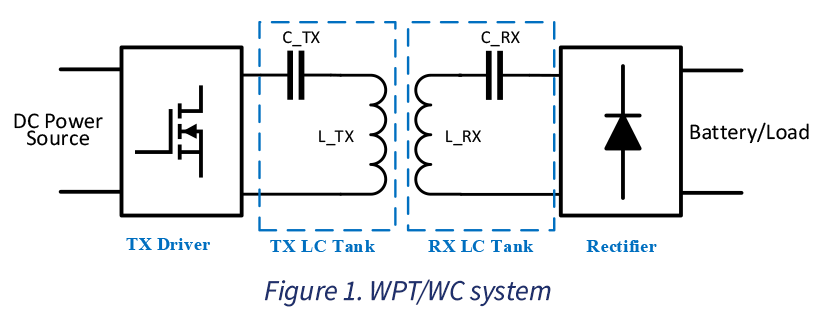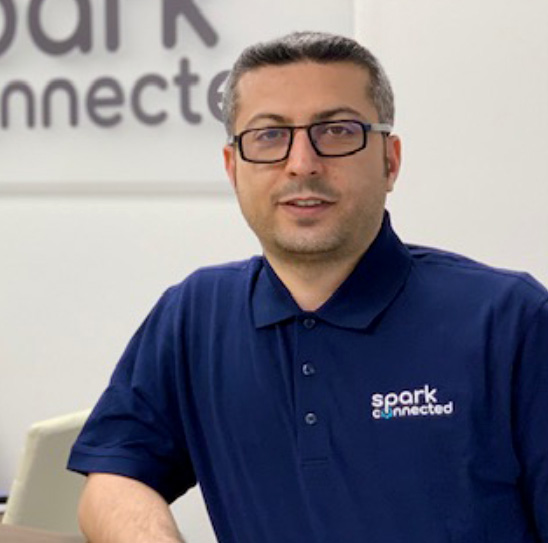INTRODUCTION
Since the public announcement of near-field coupled magnetic-field based resonant wireless power transfer (WPT) in 2006, wireless charging technology has been undergoing significant development. Since then standards bodies such as Qi Wireless Power Consortium (WPC) as well as PMA/Airfuel Alliance have been formed, among which, Qi WPC has been the main driving force in advancing and establishing the standards for the WPT and wireless charging.
Different wireless chargers including 5W legacy and 15W next-generation have been certified and utilized in the market. With the success at these power levels the industry is leaping for the next big step to hit the market with the power levels of 30W, 45W, 60W, and beyond. The application for these power levels could involve laptops, drones, autonomous robots, power tools, etc.
OPERATION PRINCIPLES
The near-field wireless power transfer operates based on the magnetic-filed coupling of the transmitter (TX) and receiver (RX) coils. The magnetic field is stablished with alternative current (ac) at different frequencies including radio frequency (RF), resonant, or near resonant frequencies, where the latter is designed for inductive charging. Figure 1 depicts a near-field coupled WPT/WC system. Depending on the switching frequency of the TX driver as well as LC tanks resonant frequency the system could be designed to operate in one of the three aforementioned operation modes.

The TX driver output is an ac voltage with a fundamental frequency at which the system is designed for. This voltage supplies the TX LC tank with an ac current establishing a magnetic field in the TX coil. When a wireless power receiver is at the presence of this filed, the coupling between the TX and RX coils induces an ac voltage across the RX coil which yields to an ac voltage at the input of RX rectifier. This ac voltage is then rectified to either charge a battery or supply a load.
The deceptively simple appearance of this system has demanded enormous effort from EE engineers to improve its efficiency and reliability in competition with the wire-based chargers. Although, 5W WC systems have shown a promising dependability and met the market’s demand, the 15W is still challenging the technology leading companies and agencies. The challenge is not only optimizing the systems for a higher efficiency but also their reliability is highly dependent on the communication system between TX and RX. The communication system provides a negotiation mechanism through which the TX and RX establish a power transfer agreement. The traditional communication between the TX and RX in the 5W systems has been based on a low-bandwidth in-band communication where the message is modulated on top of the power signals at its origin and then is demodulated from the power signals at its destination. The in-band modulation is usually implemented through amplitude shift keying (ASK), frequency shift keying (FSK), or phase shift keying (PSK), or a combination of these methods. It can be conceived that this communication method could be affected by the dynamics of the power signal. Therefore, the gateway to the higher reliability of WC systems at power levels of 15W and beyond is enhancing their communication robustness independent from the power signals dynamics and therefore improving overall system reliability. The possible solution could be the out-of-band communication with high bandwidth and bit rate such as Bluetooth, NFC, or similar technologies.
Development of higher power WC systems for applications where simultaneous power and data transfer are needed could be a revolutionary transition to a cord-less world. The application of these WCs in consumer electronics, especially in laptops would be the beginning of an integrated wireless charging and data transfer unit. In this outlook a transmitter unit, e.g., a laptop docking station at the power levels of 45 – 200 Watts could be utilized as both power and data transfer wireless link. At the front-line of battle between the wired and wireless world a technology leader such as Spark Connected is fulfilling its mission towards Powering the world, wirelessly™ by developing the most advance and reliable 45 – 200 Watts WPT and WC systems.

Malek Ramezani
- Senior Power Electronics Engineer
- PhD in Electrical Engineering from The University of Alabama
- Co-chair for Foreign Object Detection (FOD) at the Wireless Power Consortium (WPC/Qi)
About Spark Connected
Spark Connected | powering the world, wirelessly
Spark connected is an industry leader specializing in multiple advanced and safe wireless power technologies that benefits a wide variety of applications in the Automotive, Industrial, Infrastructure, Medical, Telecom and Security, Robotics, Factory Automation, IOT, Smart Home, and Consumer markets.
Spark is transforming wireless power delivery and intelligent battery charging with innovative platforms, disruptive technology and breakthrough products enabling an enhanced user experience for all. The company specializes in Product Development and Engineering Solutions with a team of passionate innovators with decades of combined deep domain expertise.
Spark Connected is a Full Member of the Wireless Power Consortium.
Please forward inquiries to:
Marina Wolf/Ruwanga Dassanayake
(972) 855-8026
sales(at)sparkconnected.com
